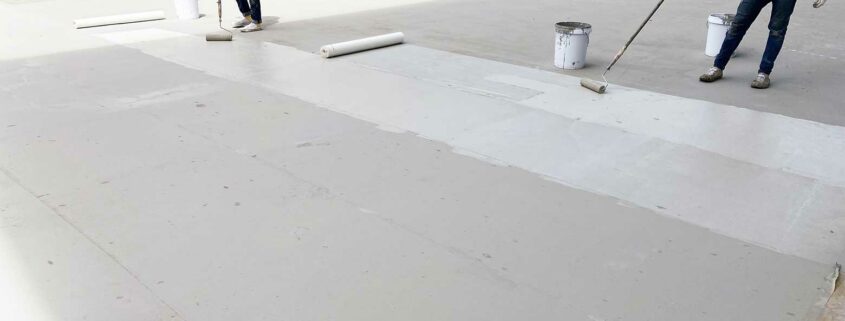Commercial buildings are unique in that their commercial roofs have to handle more stress than residential roofs (so they tend to be thicker and sturdier). They have to be dependable – after all, they’re protecting your employees, your customers, and your investments.
If you see a leak in your commercial building’s roof, it’s important to act quickly so that the problem doesn’t get worse. Even though a leak may be minor, it can be an indicator of a more serious issue going on with your roof. Let’s take a look at some important warning signs and what all building owners should do if they suspect a leaking roof.
Commercial Roofs vs. Residential Roofs
Commercial buildings have many of the same basic needs as residential buildings, and those needs fall into three categories: insulation, drainage and structural integrity.
However, commercial roofing systems are different from residential roofs because they have to withstand more stress than homes typically do. Commercial flat roofs have to span larger areas, because commercial properties have larger footprints. And due to their larger size and flat nature, ponding water tends to be more of an issue.
Flat roofs also require unique drainage systems. On sloped residential roofs, water runs down shingles (or a metal roof) to gutters, into downspouts, and the ground. However, on a commercial flat roof, water is directed to drainage systems that run underneath the roof. Water near the edge of the roof drains off the building through scuppers, which are openings in the parapet that runs around the entire roof.
Commercial buildings also tend to have more penetrations (like skylights or exhaust fans) than homes do, which puts additional strain on the structure; this means that installing new materials without compromising stability can sometimes be tricky.
Signs of a Commercial Roof Leak
Wondering if you have a roof leak? Well, there are some common signs you can look for on the inside of your building. The first, and most obvious sign, is water. Remember that water can travel long distances from the penetration, down pipes and ceiling structures – so, just because you see water dripping doesn’t necessarily mean you’ve found the source of the leak.
Water stains on walls are signs of a leak, as well, which may indicate that the leak site is on the edge of the roof membrane.
A musty odor in your building is another telltale sign of a roof leak. Mold, fungus, and mildew can grow where there is excess moisture coming into the building.
Sources of Roof Leaks
Commercial roof leaks can be the result of a number of causes. Let’s look at the most common causes of roof leaks in commercial buildings.
HVAC Systems and Other Penetrations
HVAC systems are part of most buildings’ infrastructure, so it’s easy to overlook them as a cause for leaks. Even on small commercial buildings, HVAC units are usually mounted on the roof to save valuable space around the building.
HVAC systems need to penetrate the roofing material in order to deliver warm or cool air. These penetrations are always closed with sealant, but over time, weather damage and temperature swings make these seals prone to leakage.
Weather-Related Roof Damage
It seems obvious, but a damaged roof is a major cause of roof leaks. Damage can come in many forms – weather is a major factor, especially if your building is located in an area prone to severe weather conditions. High winds can throw branches and other debris onto the roof and cause punctures in the roof coating.
Water Damage
Water damage is a huge contributor to roof leaks. Water damage usually starts with improper drainage, due to clogged drains or lack of slope on the roof.
Water can collect on the roof and eventually causes the roof material to break down. Once breakdown occurs, the water seeps under the roof membrane, and when the sun heats the water, blisters form. Blisters separate the topmost layer of material from the underlying layers.
Winter is also not kind to roofs. Snow can melt and then refreeze, opening the seams between sheets of roofing material.
Preventing and Repairing Commercial Roof Leaks
Get Regular Roof Inspections
All building owners should make roof inspections part of their regular roof maintenance routine. Getting a roof inspection at least twice a year, after spring and after fall, will go a long way toward avoiding costly roof replacement in the future.
Repair Leaks as Soon as Possible
A small leak is guaranteed to cause further damage if not repaired immediately. Leaks are often the culprit behind structural damage, water damage to floors and walls, electrical damage due to corrosion of metal parts, fire hazards from improper wiring connections, and health issues due to contaminated air quality.
Partner With Roofing Experts
Leaks can be a major problem for commercial buildings, but they don’t have to be. It’s important to have a commercial roofing contractor you trust who will give you honest and straightforward recommendations about what roofing solutions are right for you.
If you own or are overseeing a building with roof leaks, contact TEMA Roofing Services. We’ll evaluate your roofing needs using our vast experience in the commercial roofing industry. Whether you need a leaky roof repaired or a new roof installation, we will take care of your commercial roof using only high-quality materials and workmanship. Contact TEMA today!





